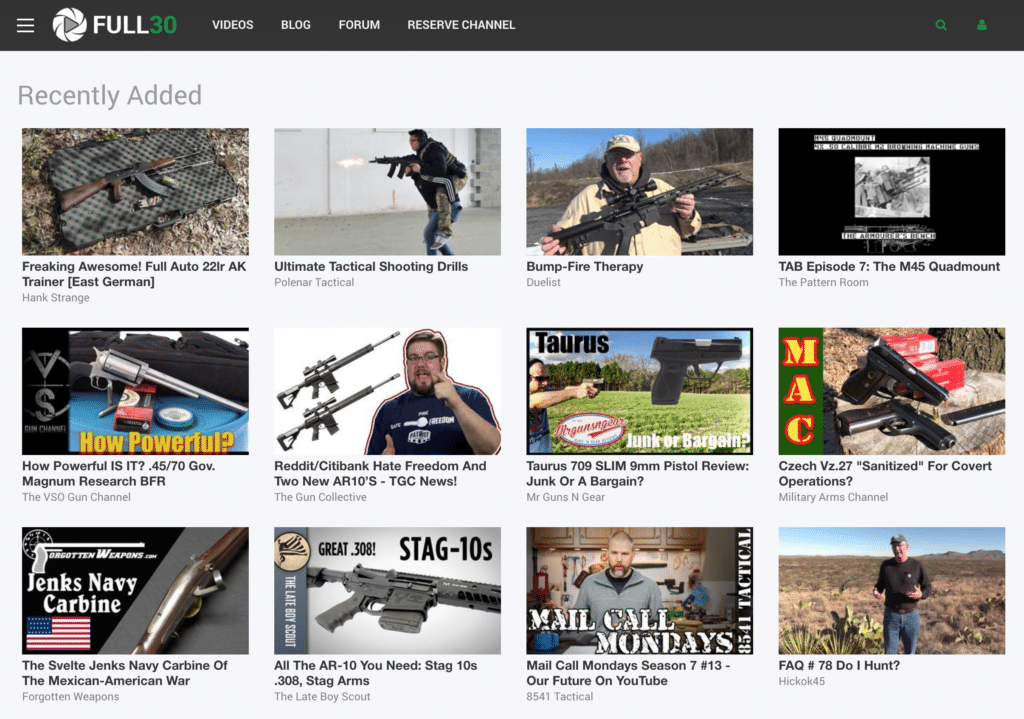
Last week, YouTube dropped a highly restrictive policy on the firearm industry and gun content creators that—for the most part—prevents the publishing of all firearm-related content.
Much like Facebook, YouTube now acts as a virtual public square. The exercise of what amounts to censorship, then, can legitimately be viewed as the stifling of commercial free speech, which has constitutional protection. Such actions also impinge on the Second Amendment. (Source: NSSF)
Digital marketers in the firearms industry have been stripped of Facebook Advertising, Google PPC and now YouTube, which will ultimately hinder growth and sales in the digital age for the short term until alternative channels have time to develop.
Over the past week, I’ve watched the industry’s reaction to the situation as well as content creators like TGC News, Military Arms Channel, Tactical Toolbox and others. And like you, I wonder what this means moving forward without the use of YouTube’s free platform to leverage the benefits of influencer marketing, product reviews, training and educational content that is so important to communicating and reaching prospective law-abiding customers and outdoor enthusiasts.
This is a severe blow to the industry and a direct assault on First and Second Amendment rights. And when you calculate the thousands of hours and millions of dollars gun creators and brands have devoted to YouTube, the investment has been substantial.
In this post, I want to give you a few thoughts from a marketing perspective about what the future holds for firearm marketers, gun content creators and brands with the loss of YouTube.
1. Back to the future
Where were you in 2005 when the YouTube.com domain was registered? I remember SEO was a simple matter of placing keywords on your website to get first page rankings. We enjoyed open email rates of 50% or higher, all the while, Mark Zuckerberg was in his dorm room at Harvard building a website called Facebook. Much of the digital channels we utilize today were unavailable. Magazine ads, catalogs, a visit to the local dealer and gun shows were the only way for people interested in firearms to find out about new products.
In just 13 years, after YouTube’s $1.65 billion acquisition by Google (2006), it has grown to the world’s second largest search engine with over 30 million visits per day and 300 hours of video uploaded every minute.
These are massive numbers, and by all estimations are only getting larger.
6 out of 10 people prefer online video platforms to live TV and by some predictions, by 2025, 50% of all viewers under the age of 32 years old will not subscribe to a pay-TV service. (Source: Fortune Lords)
The three most important metrics to any digital marketer is reach, engagement, and conversion. Without entrance to the YouTube platform, industry marketers have been cut off from a significant channel of communication to achieve these metrics.
This leaves us with only a handful of viable digital channels and tactics to consider in our marketing mix:
- SEO
- Content Marketing
- Email Marketing
- Ecommerce
- Automation
- Referral Marketing
- Lifestyle Marketing
- Native Advertising
- Banner Ads
- PR
- Sponsorships and paid placement on Publisher sites: RecoilTV, MOTV, SOFREP and others.
- Influencer marketing via Facebook, Instagram, Twitter and Pinterest
- Organic Facebook posts – which only get 1% reach
2. Hurry up and wait
With YouTube taken off the table as a choice for free content distribution, what’s the alternative?
There are only a few options when you take into account Vimeo, BitChute, Twitch, LiveStream and a few other obscure channels.
- Full30 – Free to sign up, but limited due to a small infrastructure and audience. Full30 is opening up soon to all content creators, but it may be a while before they can handle the bandwidth.
- Patreon – Pay to subscribe for as low as $1 per month
Paid subscription channels like Patreon may be a barrier for some smaller channels.
With a very limited list, we will have to wait until other channels—free of industry influence and publishers—are developed. One company reportedly working on this are the founders of Utah Gun Exchange.
Some content creators have gone to PornHub. I am absolutely against this and will not advocate or allow any brands that we represent to be promoted on that platform—for obvious reasons.
3. A pause in growth
As a marketer who has relied on social media and YouTube to drive results in the past, I am moving my clients to other strategies and tactics to achieve their goals online. I think we all should expect the possibility that Facebook, LinkedIn, Instagram and Google Search may soon censor gun content as well.
4. What’s next?
Like the Facebook algorithm change in January, this will also need time to play out. I’ve always been a proponent of brands and content creators taking a “website first approach” that provides their own private platform to build their audiences rather than relying on third-party channels that are anti-gun. Google doesn’t own the internet. Developing your audience on your own website will always be a good fall back when significant disruption happens. By building your traffic, email subscriber list and then using social media as a distribution channel, you’ll always have plenty of options when disruption comes.
Regardless, things have inherently changed, and the firearms industry has been pushed out to the fringes of the digital world. I believe YouTube’s decision will only make our industry stronger in the long run.



